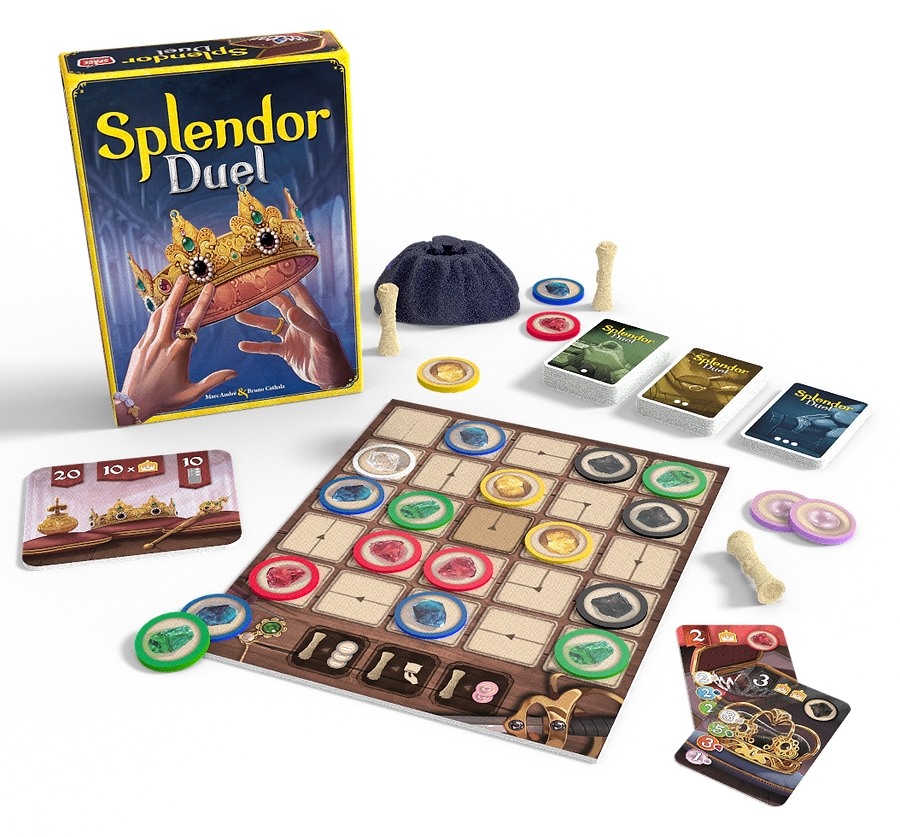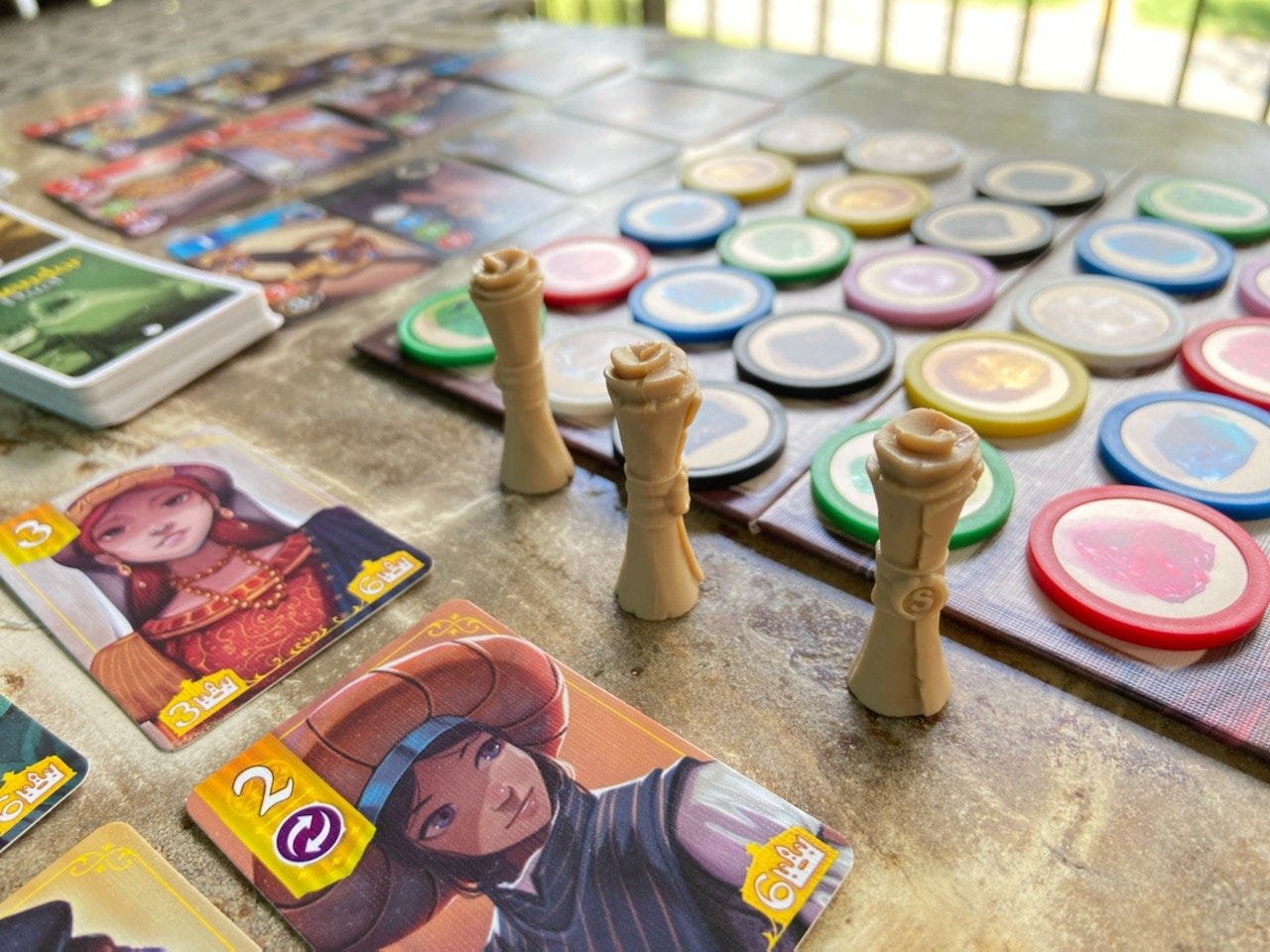Board Game Review - Splendor Duel
A diamond in the rough
Splendor Duel has a lot in common with 7 Wonders Duel in that both are based on popular, entry-level board games that strip the experience down to a two-player experience and, in my opinion, vastly improve upon it. Of course, given that Bruno Cathala is the mastermind behind both games, I suppose it shouldn’t be much of a surprise. While Splendor is an enjoyable enough set-collection game, and works well to introduce folks who might not be as into the hobby, I’ve never felt like there was enough depth there to keep me interested for long, especially not at two players. Enter Splendor Duel, which solves that problem along with a couple other ones I hadn’t even noticed.
Splendor Duel still borrows heavily from its predecessor. You’ll be collecting gemstones, reserving cards to pick up gold tokens, and spending them combined with the bonuses from your previously-purchased cards to fill new orders on the table. However, just like 7 Wonders Duel before it, Splendor Duel smartly adds an element of geometry to the decision space. Rather than just having an indiscriminate pile of gemstones on the table that you can choose from every turn, you instead fill out a spiral-patterned board and must select tokens in a straight line. This, obviously, limits your options, and it forces you to think a bit more strategically about what cards you might want to complete.
The strategy deepens when you add in the fact that completing an order means your tokens are returned not to the board, but to a bag that will eventually be used to refill the board. Suddenly, Splendor Duel becomes a war of attrition — sure, you could use your turn to turn in your gems for that card you’ve been eyeing, but maybe you want to snap up those pieces from the board before your opponent gets the chance to do so. Just like in the original, you can reserve a card for yourself to pick up a gold token from the board — which can be used as a gem of any color — but you can only hold onto three cards at a time. After that, you’ve got to complete one of them before you’re allowed to take another gold piece.
Splendor Duel also makes things more interesting by adding Privileges, scrolls you’ll get to pick up any time your opponent takes three tokens from the same color off the board, or starts their turn by refilling the board. You’re allowed to refill the board at any time you want — though you’ll be left no choice if it’s empty on your turn and you can’t complete any cards — which naturally gives you first pick of the new selection at the cost of your opponent getting a boost, too. The Privileges are handy, letting you grab a free token off the board at the start of your turn, and this can be leveraged into surprisingly effective turns if you know how to use it. Thus, a tug-of-war is formed as neither player really wants to refill the board, but eventually someone will have to cave.
As you complete cards, you’ll be earning points, crowns, and bonuses — cards of a certain color can be used to substitute gems of that color when filling out an order — and figuring out the path you’re going to try and take to victory. Splendor Duel has three different victory conditions: collecting 20 points overall, 10 points of the same color, or 10 crown icons across all your cards. Every three crowns also gives you a chance to grab a special golden card which comes with some kind of extra benefit, too.
Splendor Duel also adds pearls, a new variety of gem which is exceedingly rare and doesn’t appear as a bonus on any card. Because of the pearls, even if you have a massive collection of cards covered in bonuses, you’ll always eventually have to take a token off the board, or refill it once it’s out of pearls and gold. This is a really clever addition that keeps the game unpredictable and exciting as it approaches its end. In the beginning, it’s all about building up an engine of reliable gem colors and points, but by the end, whoever controls the pearls controls the world.
Some cards also have special instant abilities that have lots of potential to shake things up or make things nasty — a free Privilege, a bonus color of your choice, or even the chance to steal a gem from your opponent — and you can also find these on the bonus cards you get for having three crowns in your tableau. Because there’s really no secrets or surprises in Splendor Duel, you have to manage your own cards and gems well while also keeping track of what your opponent might do that could screw up your plans, and these extra abilities add a lot to that calculation.
My only real gripe with Splendor Duel would be that it’s sometimes a little tedious to lay out all the tokens onto the board, but this is a very small price to pay for a truly satisfying two-player experience, especially considering how delightfully weighty and smooth the tokens are. The original is fun enough for a group of three or four, but if it’s just me and one other person, I’ll always pick Splendor Duel over it. With its simple, two-page rulebook and nearly nonexistent setup time (especially compared to 7 Wonders Duel), it’s pretty much a no-brainer.




